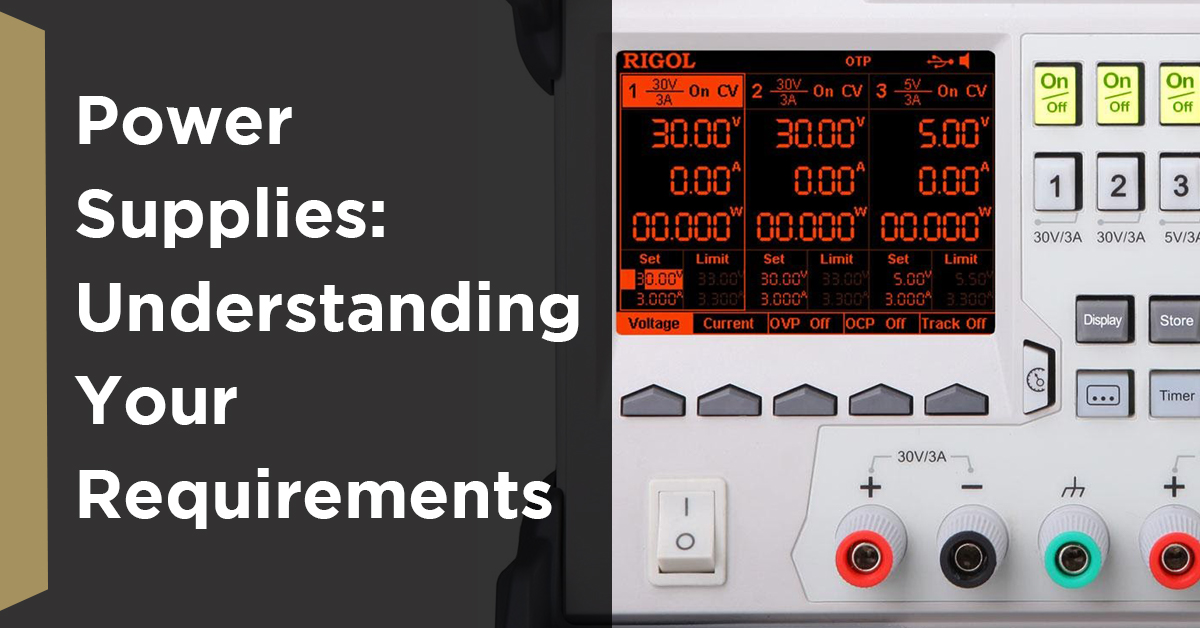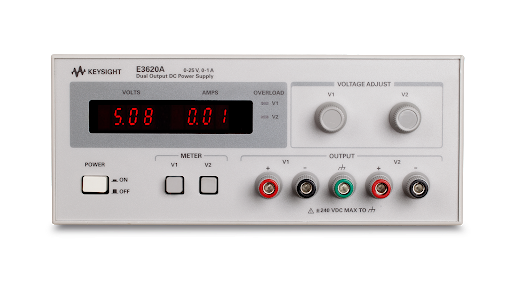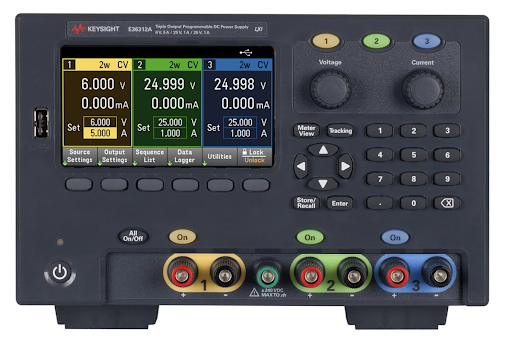Best DC Laboratory Bench Power Supplies of 2021

Understanding YOUR Requirements
Recently I was faced with purchasing a few new power supplies. I searched the world wide web far and wide for guides and recommendations but found no single comprehensive guide, or at least not one that includes power supplies from the last decade.
Hopefully, this guide will fill that niche and help make your decisions swiftly and confidently.
Power supplies are like a pair of shoes: Supermarket-grade or high-fashion; the most important parameter is how well they fit you.
Let’s get through the requirements one-by-one, and then we will discuss the technological tradeoffs, and recommended brands and models.
All views and opinions expressed in this article regarding power supplies and their brands are those of the authors and do not necessarily reflect the position of Altium.
Voltage and Current
Most power supplies on the market reach 30V on the main channels, a voltage that will cover almost all requirements for low-voltage consumer electronics. If you work with industrial electronics or other fields where 48V are common, you should consider a 55-60V power supply.
Specialist power supplies are available with maximum voltages over 60V, but they start to become dangerous for desktop use, so if you don’t need them, don’t buy them. Naturally, some companies that specialise in high-current and high-voltage power supplies produce models up in the kilovolt range.
The current is more fickle to evaluate and will vary greatly depending on what kind of electronic products you’re working on.
How much are your devices worth?
Let’s do a mental-experiment, Einstein-style. You’re sitting at your workbench, you didn’t sleep too well, and it’s not clear if your boss is breathing over your neck intentionally or if they just like your cologne, and you’re a bit stressed out. Maybe you skipped your morning cup of Joe and would rather nap on a pile of discarded THT resistors, like a fox curled on a bed of pine needles.
You brush a knob with your elbow, misconfigure the power supply and blow up the board you were working on.
.jpg)
What’s the damage?
Do you work with sub-$100 consumer-grade electronics, or do you work with multi-thousand dollars 12 layer FPGA prototypes? Can your devices be easily replaced? Does it get you 12 minutes of tweaking and bodge-wiring to get your boards working or 12 days of exorcism?
If either your devices or your time is valuable, you should choose a power supply with a lockable front-panel and an output switch so you can configure it correctly before turning it on.
In any case, you should choose a model that feels ergonomic and intuitive for your use. In this regard, check the difference between the Keithley 2231A featuring a simple and intuitive left-to-right panel compared to the more confusing rainbow of colours of a Rigol DP832A.
An additional safety feature many programmable models offer is over-voltage protection (OVP) and over current protection (OCP). For example, if you’re using the power supply for a circuit that can withstand 0-5.5V, set the OVP to 5.5V. This way, even if you misconfigure the output, for example by changing the wrong digit or entering “9” instead of “5” on the numeric keypad, you will trip the OVP instead of destroying the device under test.
Fully Floating Outputs
Almost all bench power supplies have fully floating outputs, meaning none of them is connected to safety earth in any way.
Floating outputs can be connected in series without shorting them accidentally, and can be used freely with circuitry that is already referenced to ground.
Additionally, you may want to keep your power supply floating so you can have a single star-ground on your device to reduce electromagnetic interference and improve measurement accuracy.
If you do need to reference your power supply to ground, most of them include a handy earth connector on the front.
Binding Post
Power-supply binding posts should be hybrid devices. You want to be able to connect 4mm bananas, either shrouded or unshrouded, just as quickly as you can plug in a random wire.
The best in the market are, in my opinion, AIM-tti’s hybrid binding posts, that can accommodate pretty much any kind of connection while maintaining a safe level of electrical isolation.
Resolution, Precision
A DC power supply it’s not just “one” instrument, it’s a bunch of them in one. It’s a constant voltage source, a constant current source, a voltmeter, and an ammeter.
As such, you can find multiple resolutions, accuracies, and precisions specified.
Load and line regulation
Load regulation specifies the stability of the output voltage (in CV mode) or current (in CC mode) over different load conditions. Line regulation specifies the stability over different power-grid voltages.
Typical values for high-precision power supplies are 0.01%+2mV in constant-voltage mode and 0.01% + 500uA in constant-current mode.
Cheap power supplies that do not sense the voltage near the biding posts can often have much worse load regulation.
Switching, Linear, Noise, and Ripple
The question I get asked more often when someone is faced with purchasing a power supply is: linear, or switching?
If you don’t know the answer already, you need a linear power supply!
In general, linear power supplies have better noise performance (not only Vrms but especially Vpp) compared to switching. There are, of course, exceptions! For example, Rohde & Schwarz manufacturers the HMC804x series of mixed-mode power supplies with the excellent noise performance of 450 μVRMS and 4 mVpp.
Still, even with the excellent performance, the peak-to-peak value of switching power supplies is often around ten times higher.
Many switching power supplies are cheap and offer an ample range of current and voltages, but are extremely noisy, especially regarding the Vpp.
In general, there are many tradeoffs to be made to keep noise low. For example, the manufacturer can decide to add extensive filtering to the output. Still, the filtering can interfere with the load regulation and lead to a much degraded transient response and increase the equivalent series resistance of the unit.
Less noisy units require more expensive and well-designed transformers, bulky linear circuitry as opposed to energy-efficient switching regulators, and more costly internal components in general.
Extremely low noise power supplies, such as Keysight B2962A can reach a price of over ten thousand USD.
If you, like me, design analogue circuitry, you might want to choose a low-noise linear power supply, so you don’t have to worry too much about PSRR during development.
Other Features
Programmable Slew Rate
For devices with a high inrush current, you might want to consider a power supply with a programmable slew rate; a feature often offered with output sequencing.
New or Used
The essential features of power supplies have been the same since the late 70s, but companies haven’t stopped innovating. Keysight and Rohde & Schwarz recently introduced last-generation DC power supplies that incorporate a large and bright LCD touchscreen and can take advantage of advanced programmability features, data logging, and output sequencing, without the need of an external computer and coding custom software.
If you need advanced programmability and do not have the infrastructure to control GPIB instruments, new instruments with embedded computers and LAN interfaces may be the only viable option.
Close to Zero
Many power supplies, especially the cheaper ones, cannot set voltages close to zero. If this is important for you, you should buy from reputable manufacturers and search the web for independent reviews and measurements.
Brands
As flexible laboratory power supplies are fundamental in any electronic lab, power supply manufacturers are some of the earliest companies to be born in industrialized countries. The US, UK, Germany, and China all have world-leading manufacturers of DC power supplies.
If you want your products to be a long-term investment, brand matters. The Following brands are known for manufacturing excellent high-tier laboratory power supplies:
- Keithley
- Keysight (formerly Agilent, HP)
- Aim-TTI
- Rohde and Schwarz (Formerly Hameg)
Additionally, these brands are less known for their quality, but still offer many interesting instruments for their price:
- Rigol
- GW Instek
- BK Precision
Recommendations 2+ Channels: Jack of all Trades
Budget Options: Basic
Simple and affordable power supplies are too numerous to be discussed in this article. If you want to buy one, make sure it’s linear and from a reputable manufacturer. If you live in a well-industrialized country, buying local is probably the best option.
If you’re interested in import models, the EEVBlog forum is usually the best place to look for teardowns and reviews.
Budget Options: Last-Gen Features
Rigol DP832
.jpg)
The Rigol DP832 and DP832A have been the cornerstone of affordable power supplies. Initially, the instrument was plagued by quality issues, with a notorious overheating internal heatsink. The design is controversial, and there have been numerous reports of power-on spikes, slow voltage response at low currents, slow OVP/OVC. Over the past few years, it has refined and matured, and it’s now considered an excellent instrument for the price.
|
Maker |
Rigol |
|
Model |
DP832 |
|
Documents |
|
|
Technology |
Linear |
|
Channels |
2x 30C 3A, 1x 5V 3A |
|
Connectivity |
LAN LXI, USB, USB Host, RS232, DIO |
|
Noise |
<350uVrms, <2mVpp |
|
Setting Resolution |
10mV, 1mA (1mV Optional) |
|
Setting Accuracy |
0.05% + 20mV, 0.2% + 5mA (ch1 and ch2) |
|
Meter Resolution |
10mV, 1mA (1mV optional) |
|
Meter Accuracy |
0.05% + 10mV, 0.15% + 5mA (ch1 and ch2) |
|
Load Regulation |
<0.01% + 2mV, <0.01% + 250μA |
GW Instek GPP-4323
.jpg)
GW Instek is trying to push their instruments into competing with western brands. This unit features a large 4.3 inch LCD and up to 4 outputs. Compared to the Rigol, it offers improved resolution, load function (CC, CV, CR), one extra channel, and hardware OVP and OVC (opposed to software).
The lack of a peak-to-peak noise specification, as well as a dubious noise measurement of only 1Mhz instead of the industry-standard 20Mhz, casts doubt on the noise performance.
Still, many big brands such as RS and Teledyne Lecroy have put their name in front of GW-Instek instruments, rebranding them as their own.
|
Maker |
GW Instek |
|
Model |
GPP-4232 |
|
Documents |
|
|
Technology |
Linear |
|
Channels |
2x 32V 3A, 1x 5V 1A, 1x 15V 1A |
|
Connectivity |
LAN LXI, GPIB USB, USB Host, RS232, DIO |
|
Noise |
<350uVrms, Vpp not specified, RMS only to 1Mhz |
|
Setting Resolution |
1mV, 0.1mA |
|
Setting Accuracy |
0.03% + 10mV, 0.30% + 10mA |
|
Meter Resolution |
0.1mV, 0.1mA |
|
Meter Accuracy |
0.03% + 10mV, 0.30% + 10mA (ch1 and ch2) |
|
Load Regulation |
<0.01% + 3mV, <0.01% + 250μA |
Budget Options - Plenty Of Quality - Local Control
Aim-TTI EL302RT
.jpg)
Maybe you haven’t heard of Aim-TTI, their name is not as glamorous as Keithley and Keysight, but they are of the leading manufacturers of DC power supplies with impeccable building quality (made in the UK) and excellent electrical performance.
They have a seemingly endless number of power supplies. Their entry-level linear series is EL-R, and EL302RT is the three-channel model.
It’s not too precise, doesn’t have tons of features, but gets the job done. All AIM-tti power supplies feature hybrid banana/screw terminals that support wires, fork terminals, shrouded bananas, and non-insulated bananas.
|
Maker |
Aim-TTI |
|
Model |
EL302RT |
|
Documents |
|
|
Technology |
Linear |
|
Channels |
2x 32V 3A, 1x 5V 1A, 1x 15V 1A |
|
Connectivity |
LAN LXI, GPIB USB, USB Host, RS232, DIO |
|
Noise |
<1mVrms, Vpp not specified |
|
Setting Resolution |
Analog |
|
Setting Accuracy |
Analog |
|
Meter Resolution |
10mV, 1mA |
|
Meter Accuracy |
0.3% + 3 digit, 0.5% + 10mA (ch1 and ch2) |
|
Load Regulation |
<0.01% |
Keysight E3630A

Keysight’s offer is not as it’s best in the “budget” 3-channel market; however, they do offer one model with bipolar output and one auxiliary channel, the E3630A. If you’re the kind of engineer that sneezes uncontrollably at the sound of “RRIO CMOS Op-Amp” and has a borderline-obsessive fascination for BJT, this might be the tool for you.
And it has 10-turn potentiometers! You’ve got to love those.
|
Maker |
KEYSIGHT TECHNOLOGIES |
|
Model |
E3630A |
|
Documents |
|
|
Technology |
Linear |
|
Channels |
1x +-20V 0.6A, 1x 6V 2.5A |
|
Connectivity |
None |
|
Noise |
< 350 μVrms, < 1.5 mVpp |
|
Setting Resolution |
Analog |
|
Setting Accuracy |
Analog |
|
Meter Resolution |
10mV, 1mA |
|
Meter Accuracy |
0.5% + 2 Counts |
|
Load Regulation |
0.01% + 2mV |
Budget Options: Plenty of Quality - Usb/Rs232
Keithley 2231A-30-3
.jpg)
The Keithley 2231A-30-3 has been a worldwide bestseller since its inception, and it’s no wonder. The unit is beautiful, compact, the interface has a clear left-to-right layout with keyboard and encoder, and the VFD display is much more readable than many modern LCDs.
The only place where this power supply falls short is noise performance: at 5mVpp it has a comparable noise floor to many switching power supplies, but it’s linear.
With some interior redesign, this would probably be my favourite power supply of all time.
|
Maker |
Keithley |
|
Model |
2231A-30-3 |
|
Documents |
|
|
Technology |
|
|
|
|
|
|
|
|
|
|
|
|
|
|
|
|
|
|
|
|
|
|
|
|
|
FBK Precision BK9129B
.jpg)
It’s not always clear what BK is selling, as the company is a conglomerate of multiple manufacturers. The BK9129B is almost identical to a Keithley 2231A-30-3, with the only discernible differences being branding, the (slightly less intuitive) keyboard, and a very handsome blue bumper.
Budget Options: Plenty Of Quality - Usb/Rs232
Aim-TTI PL303QMT-P
.jpg)
Aim-TTI’s PL303QMT-P is a combination of classic design and modern technology. You get an excellent true-three-channel power supply (well, it’s basically three power supplies glued together, for a total width of 3/4 of a 19-inch rack) featuring an apparently old-school analogue interface. While the unit retains the intuitiveness of an analogue power supply, it features a front-panel lock, LAN/GPIB/USB interface, a 500mA low-current range with 0.01mA setting resolution, a configurable range for the voltage knob, remote sensing, and hybrid terminals. The low-voltage channel has 8A of current supply capability, which is truly impressive, and FPGA-friendly.
Noteworthy Advanced Power Supplies
Rohde & Schwarz NGM202
_1.jpg)
Since it’s the acquisition of Hameg, Rohde & Schwarz had some of the best power supplies in the market. Hameg were pioneers in mixed-mode power supplies with performance that makes many linear models blush. Rohde & Schwarz rocks the best touch user interfaces in the industry on their oscilloscopes. NGM202 is the beautiful baby you would expect from such a marriage of excellent power-electronics engineering and intuitive user interfaces.
Rohde & Schwarz also use statically-compiled firmware in most of their products, similarly to what the automotive industry does. So as long as the hardware doesn’t break, the firmware will continue to operate as well.
The NGM202 is a high-current, two-channel power supply with features that any engineer working with low power devices and power amplifiers will love. It has a 10nA and 5uV readback resolution, can both source and sink current, simulate batteries and has industry-leading transient recovery time.
AIM-TTI QL564P
.jpg)
All manufacturers are loading their power supplies with advanced computational features and touch screens, but what if you don’t care about these bells and whistles?
AIM-TTI QL564P may not look like much from the outside, but the numbers and features tell a different story. It has 350uVrms of noise, switchable ranges of 56V/2A and 25V/4A, watt display, 1mV/±(0.03%+5mV) and 0.01mA/±(0.2%+0.5mA) setting resolution with probably the best constant current source resolution in a general-purpose power supply, external sense, load relay, and a full numeric keyboard.
Keithley 2450 Sourcemeter SMU
.jpg)
I know what you’re thinking, this is not three channels, this is not a PSU at all!
It’s a Keithley source-and-measure unit, simply put, a very-precise 6.5 digit multimeter paired with an incredibly advanced power supply with five voltage ranges and nine current ranges.
If you always felt like power supplies should have a 500nV resolution and a 10nA sourcing range, then this is the product you should be looking at!
|
|
|
|
|
|
|
|
|
|
|
|
Keysight E36312A

The Keysight E36312A is perhaps the most anticipated power supply in history. Everyone was waiting for Keisight’s power supplies to be upgraded with an LCD and advanced embedded hardware, similarly to Rohde & Schwarz, Keithley, and Rigol’s models. And upgrade they did!
The E36312A packs outstanding features, top-notch software, and excellent resolution, including a 20mA low-current range on all channels.
|
|
|
|
|
|
|
|
|
|
|
|
|
|
|
|
|
|
|
|
|
|
|
|
|
|
|
|
|
|
|
|
|
|
|
|
Conclusion
We have discussed several power supplies, ranging from models featuring nothing but essential features to the crème de la crème of what modern technology can offer with displays that would rival a television.
You may have noticed, nowhere in this article will find low-quality and unreliable models, or models designed for hobbyists and not professionals.
The reason is simple: low-quality power supplies are a horrible investment. Try to do some napkin math: how much is a day of your work worth? How much is a prototype board worth? How much is the damage and setback from unreliable measurements due to high switching noise worth?
I’m going to guess, way more than the price difference between a “cheap” entry-level model and one of the more affordable and higher-quality offers.
Cheap, in engineering, is never worth it.
The same concept applies to designing PCBs. There are numerous PCB design suites that may appear simply more “affordable”, but offer none of the advanced features, reliability, and integration Altium Designer® offers.
Would you like to find out more about how Altium can help you with your next PCB design? Talk to an expert at Altium and learn more about making design decisions with ease and confidence.
